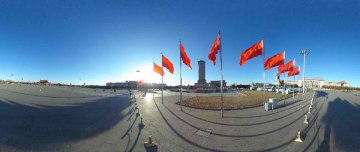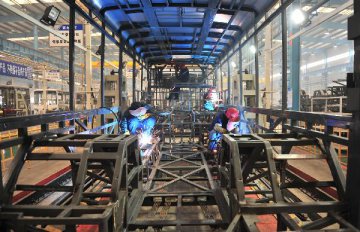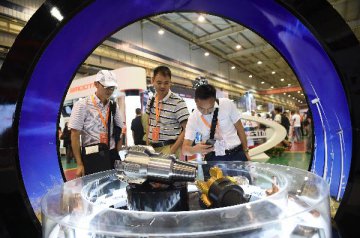
Though China’s GDP data won’t be published until tomorrow (Friday), a series of signs show that the Chinese economy undoubtedly had a good start in the first quarter. It is primarily evidenced by positive changes of seven economic indicators: investment growth, steady prices, rising business profits, a warming property market, higher fiscal revenue, rebounding market expectation and drastic reversion of foreign trade data.
In the latest World Economy Outlook issued by IMF in the night of April 12, though IMF warned of risk to global economy, it increased China’s economic growth expectation for this year and the next year to 6.5 percent and 6.2 percent respectively, which is a another sign of warming trend of the Chinese economy.
On the other hand, various well-known analysts in the capital market also maintain positive view on the Chinese economy. Industry insiders told the journalist that the risk of stagnation of the Chinese economy has reduced significantly, and the upward trend of the market is likely to be clear. When the expectation turns better, enterprises’ production and investment motivation will continue to strengthen, and their profitability is also expected to improve.
Seven indicators trend positive, Chinese economy embraces good start
The first quarter brought warm spring to the Chinese economy. Some economic indicators were even better than expected.
“I would like to use ‘rising’ to describe six positive trends and changes [of the economy],” said Zhao Chenxin, deputy director of Office of Policy Studies of the National Development and Reform Commission (NDRC) and spokesman for the NDRC. Zhao gave six important data without break, all of great significance.
Firstly, rising investment growth. Fixed-asset investment (excluding farmers) grew 10.2 percent year-on-year in the first two months and the growth rate was 0.2 percentage points higher than the annual growth in 2015, representing a pickup of accumulative growth for the first time in one year; total planned investment for newly-commenced projects increased by 41.1 percent, the highest reading since 2010.
Secondly, rising general price level. Under the combined effects of policy expectation, inventory replenishment and excessive decline earlier, prices of major raw materials such as steel and electrolytic aluminum have risen markedly. In addition, “Producer price of industrial products picked up for the first time since January 2014 on a month-to-month basis, up 0.5 percent from the previous month. Month-to-month decreasing range also narrowed 0.6 percentage points,” said Zhao.
Thirdly, rising corporate profits. “It was the first positive monthly growth since last June, reversing the trend of falling profit last year.”
Fourthly, rising sales of residential property. Sales of residential property jumped 28.2 percent in terms of floor space and 43.6 percent in terms of revenue in the first two months year on year, up 21.7 percentage points and 29.2 percentage points respectively from last year.
Fifthly, rising fiscal revenue. Fiscal revenue in general public budgets rose 6.3 percent year-on-year in the first two months, rose 4.6 percentage points and 0.5 percentage points compared with the same period and whole year of 2015.
Sixthly, rising market expectation. The manufacturing purchasing managers' index (PMI) came in at 50.2 in March, up 1.2 percentage points from February's 49, the first time it stood above 50 since last August. A reading above 50 indicates expansion, while a reading below 50 represents contraction.
“Generally, China’s economy performance remains in a reasonable range. Substantially all forecast data released by institutions home and abroad show that China’s economic growth in the first quarter is within the annual target range of 6.5 to 7 percent,” said Zhao.
It must be said that due to the restriction on administrative authority, another important data—foreign trade data has not been disclosed at the NDRC’s press briefing. But it turned out to be equally surprising after the General Administration of Customs released this data yesterday.
Drastic reversion of foreign trade data inspires market
Data shows that China’s total import and export volume recorded 1.91 trillion yuan in March, up 8.6 percent, and the export soared by 18.7 percent from a year earlier. The result, much better than expected, inspires the whole market.
Ren Zeping, chief macroeconomic strategist with Guotai Junan Securities, claimed that as China’s economy picks up and the import and export trade largely improves in March, the improving economic expectation will further back up RMB.
Unlike those firmly believing in a bullish trend, some institutions keep calm. The high export growth can hardly be maintained in the future, according to Guan Qingyou, director of Minsheng Securities Research Institute. In his view, in terms of exchange rate, the pickup of domestic economy and the decision on delaying interest rate hike made by the US Federal Reserve ease pressure on the depreciation of RMB. While in terms of external demand, main economic powerhouses across the world still see weak economic recovery.
Shenwan Hongyuan Group held similar view in its research report. “The import and export trade in March takes a turn for the better as expected, but pro-growth policies are still called for to maintain continuous positive growth.”
Bai Ming, deputy director at the Chinese Academy of International Trade and Economic Cooperation, remarked during an interview with journalist from SSN that viewed from multi-angles, the economic improvement achieved in March can be attributed to highly volatile exchange rate, small base, establishment of free trade zones and the introduction of advanced productivity.
Bai pointed out that compared with the exchange rate in Q1 2015, the exchange rate in the first quarter of this year contributes around 5 percent growth of the total yuan-dominated export volume based on the same amount of export. In addition, the export in last March suffered the biggest drop in 2015, therefore, the factor of base can never be ignored.
In addition, tax reductions were implemented at end 2015 and Jan.1 this year after the China-Australia Free Trade Agreement (FTA) and China-South Korea FTA were signed. The upgrading of the China-ASEAN Free Trade Area and the construction of domestic free trade zones all play a supporting role. The competitiveness of foreign trade companies is sharpened after the Yangtze River Delta and the Pearl River Delta, which mainly focused on labor-intensive manufacturing industry in the past, speed up the application of robotics in production. These are all positive factors shoring up the surge of import and export in March, according to Bai.
Continuous improvement of Chinese economy boosts investors’ confidence
Investors’ confidence in Chinese economy improves at the same time.
Sui Kui, chairman of Globe Moment Investment Co., Ltd., recently indicated during an exclusive interview that despite its economic slowdown, China still sees the fastest economic growth in the world. Current emerging industries see appreciable development potential and market demand. Conclusion can be drew that China’s economic transformation and upgrading will surely succeed. Investors should seize the opportunity to share the benefit brought by China’s economic transformation and upgrading.
Yang Ling, general manager and deputy president of investment decision-making committee of Beijing-based hedge fund StarRock Investment Management Co., Ltd., told the journalist that seen from the announced CPI and PPI data in March, the risk of stagflation in China’s economy has been largely lowered and the market might pick up. Though it is too early to judge whether China’s economy has bottomed out, arguments such as “Chinese economic collapse” and “hard landing” gradually fade away as a myriad of economic data improves. The market now shows increasing expectation on bottoming out of China’s economy. Under the backdrop of improving economic outlook, enterprises’ momentum in production and investment will intensify and their profit might also further enhance.
Yang indicated that “for future trend of the A-share market, we believe that as negative factors encumbering the uptrend of the market gradually weaken and positive factors propelling upsurge increase in number, the market will advance amid fluctuations. And the closer it moves towards our expectation, the clearer the uptrend of the market will be.”
Translated by Adam Zhang and Jennifer Lu
























Latest comments